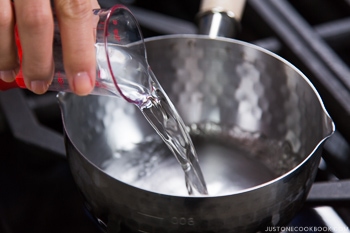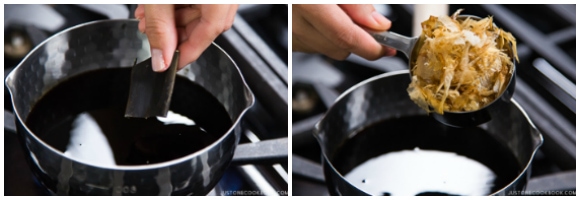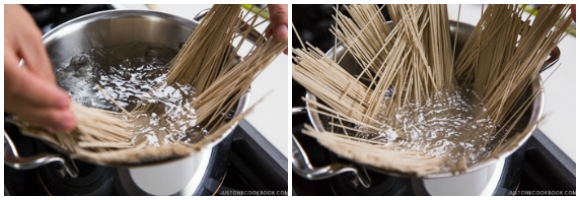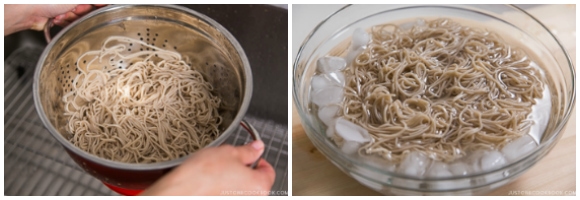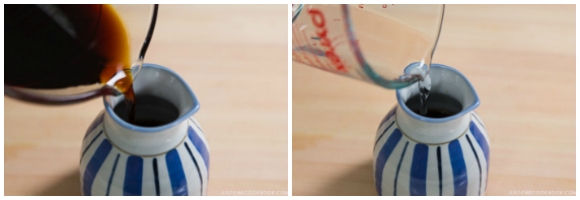Zaru Soba (Cold Soba Noodles) ざるそば
Light and refreshing, Zaru Soba (Cold Soba Noodles) will be your summer go-to staple. Ten minutes is all you need to whip up this delicious Japanese chilled noodle dish.
Is there any specific hot-weather food that you enjoy in your culture? In Japan, during the unbearable hot and humid summer, the classic cold Japanese noodle, Zaru Soba (ざるそば) is the perfect dish to cool down!
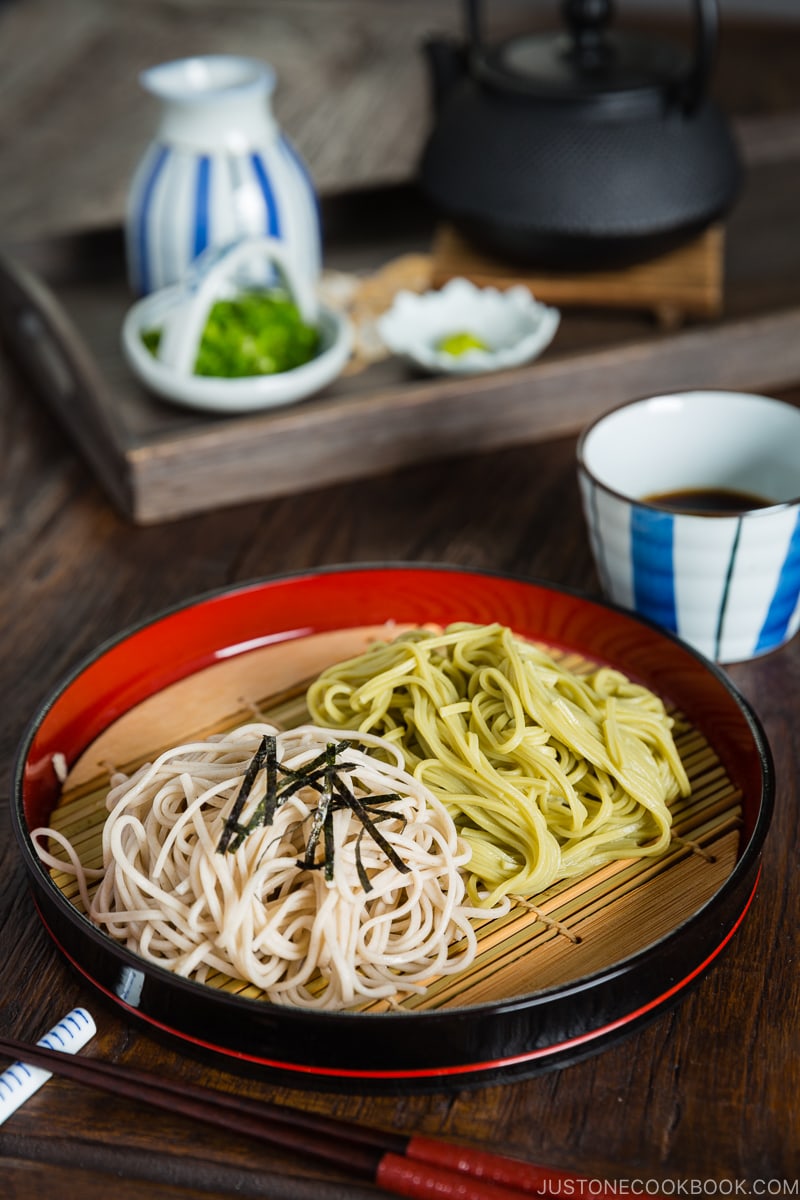
What is Zaru Soba?
Zaru Soba (ざる蕎麦) is a traditional chilled noodle dish made from buckwheat flour and served with soy sauce-based dipping sauce called Tsuyu (つゆ).
The word zaru means “a strainer” in Japanese and the name of the dish was derived from the way the noodles are served over a bamboo strainer during the Edo Period.
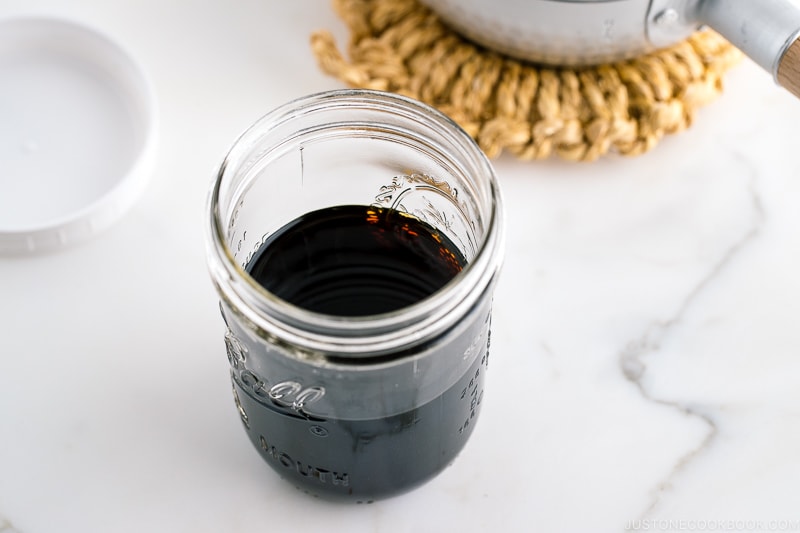
Make Homemade Tsuyu (Dipping Sauce)
Zaru soba is always served with a soy sauce and dashi-based sauce to enjoy. In today’s recipe, I share how to make the homemade dipping sauce, mentsuyu (noodle soup base), or often called tsuyu. You just need a few common pantry ingredients to make this, and I usually make it ahead of time to use noodle recipes.
Even though I make a homemade version, I keep a bottle of mentsuyu in my refrigerator so I can quickly use it when I don’t have the homemade version. You can buy a bottle in a Japanese or Asian grocery store.
Metnsuyu is often concentrated (and my homemade version, too). All you need to do is to combine 1 part of cooled dipping sauce and 2-3 parts of iced water in a serving pitcher.
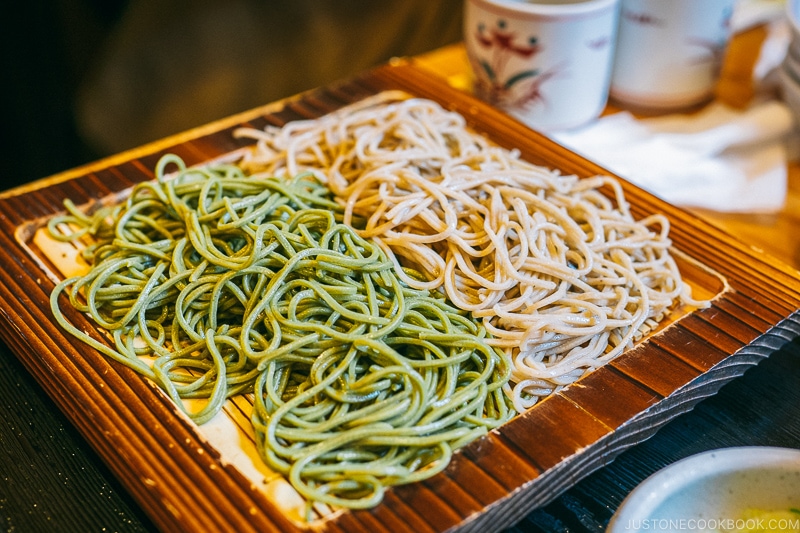
Types of Soba (Buckwheat Noodles)
There are different varieties of soba noodles in Japan, but the primary differences are texture and flavors.
The Ratio of Buckwheat Flour
- Ju-wari Soba (十割そば) is made of 100% buckwheat flour. It has a dry and rough texture so the noodles break easily. Ju-wari soba has a strong buckwheat aroma and flavor, and it can be hard to make because of the dry and crumbly texture.
- Hachi-wari Soba (八割そば) is made from 80% buckwheat flour and 20% wheat flour. Hachi-wari means 80% in Japanese. The noodle is much smoother and it has an al dente texture. Unlike Ju-wari Soba, it’s easy to swallow and chew. However, the buckwheat aroma is less pronounced than Ju-wari.
It’s hard to say which soba is tastier and more delicious; it really depends on personal preference!
Different Flavors for Buckwheat Noodles
You might have seen packages of green or pink soba noodles in Japanese grocery stores.
- Green Tea Soba (Cha Soba, 茶そば) – The noodles are flavored with a small amount of green tea powder to give a subtle green tea taste and green tint.
- Ume Plum Soba (Ume Soba, 梅そば) – The noodles are flavored with Japanese ume plum and have a slight pink color.
👉🏻 Interested to learn more about soba noodles? Read my pantry post which includes the origin, nutrition, and recommended brands for soba noodles.
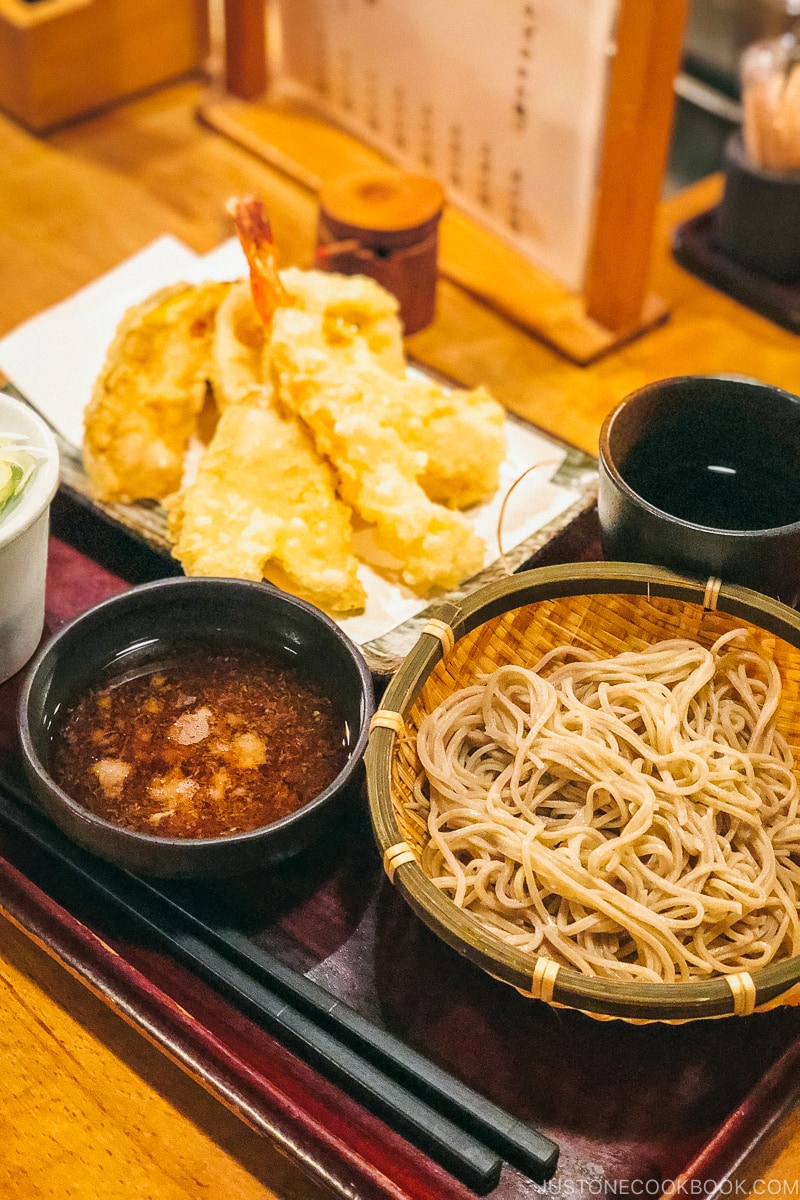
5 Important Tips When Cooking Soba Noodles
- Prepare a large pot filled with plenty of water. Even if you’re cooking for one person!
- Separate the dried noodles when adding to the boiling water.
- Stir the water with chopsticks so the soba noodles are not stuck together.
- Rinse the noodles under cold running water to remove the starch.
- Chill the noodles in ice water for 30 seconds. The noodles will firm up for a more chewy texture.
How to Eat Soba Noodles Correctly in Japan
Zaru soba is unquestionably a simple dish, but we do have a protocol on how to eat the noodles.
At the table, place the pitcher of dipping sauce (tsuyu) and small dishes that contains chopped green onions and grated wasabi. Each person has a plate (or zaru) of soba noodles and a small bowl or cup for dipping sauce.
Serve yourself the dipping sauce in the small bowl/cup and add some condiments of your choice such as green onion, wasabi, grated daikon, sesame seeds, or grated ginger. Then pick up some soba noodles, dip them in the dipping sauce briefly, and slurp the noodles. The dipping sauce is salty, so don’t soak the noodles in the sauce for a long time.
When you’re done with the noodles, you can pour the reserved sobayu (そば湯)— soba cooking water —into the rest of your dipping sauce in the bowl/cup and enjoy it as a soup broth.
You can enjoy soba in the context of a meal with a variety of accompanying vegetables such as mushrooms, carrots, daikon radish, and lettuce/cabbage-based salads.

Serve Zaru Soba with Tempura
At soba or udon noodle shops, it’s very common to serve the noodles with tempura. When we serve zaru soba with tempura, we call the dish tenzaru (天ざる).
My mom usually serves zaru soba with Vegetable Tempura and Shrimp Tempura. This Japanese cold soba noodle is a perfect summer dish, but it’s a bit challenging to deep-fry tempura when it’s scorching hot outside… But I can definitely say tenzaru is worth the effort!
More Soba Noodle Recipes You’ll Love
- Soba Noodle Salad
- Soba Noodle Soup (Kake Soba)
- Toshikoshi Soba (New Year’s Eve Soba Noodle Soup)
- Oroshi Soba (Japanese Chilled Soba in Savory Sauce)
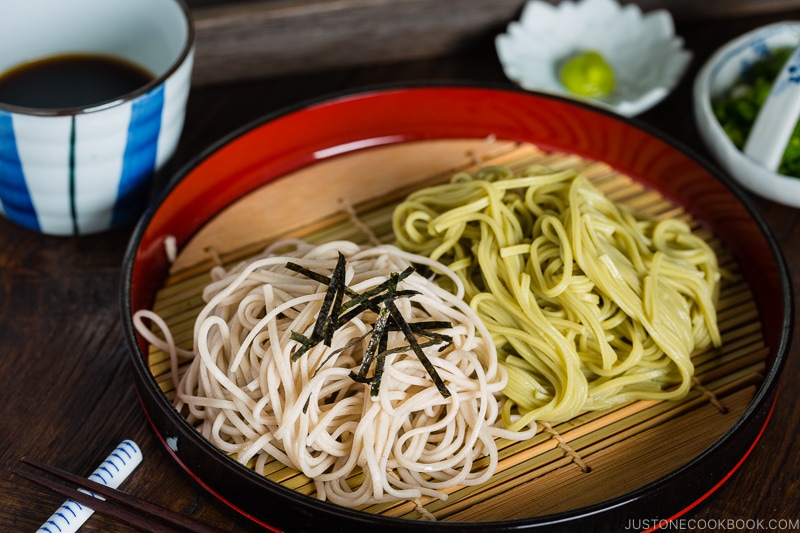
Wish to learn more about Japanese cooking? Sign up for our free newsletter to receive cooking tips & recipe updates! And stay in touch with me on Facebook, Pinterest, YouTube, and Instagram.
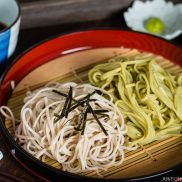
Zaru Soba (Cold Soba Noodles)
from votes Light and refreshing, Zaru Soba (Cold Soba Noodles) will be your summer go-to staple. Ten minutes is all you need to whip up this delicious Japanese chilled noodle dish. Print Pin
Video
Prep Time: 5 minutes Cook Time: 10 minutes Total Time: 15 minutes Servings: 4
Ingredients US CustomaryMetric 1x2x3x
For the Homemade Mentsuyu (Concentrated Noodle Soup Base)
- ▢ ¼ cup sake
- ▢ ½ cup soy sauce
- ▢ ½ cup mirin (plus 1 Tbsp, to taste)
- ▢ 1 piece kombu (dried kelp) (1 x 1 inch, 2.5 x 2.5 cm per piece)
- ▢ ½–1 cup katsuobushi (dried bonito flakes) (packed; if you like a more intense flavor, use the larger amount)
For the Zaru Soba
- ▢ 14 oz dried soba noodles (buckwheat noodles) (3.5 oz, 100 g per serving)
- ▢ shredded nori seaweed (kizami nori)
- ▢ 6 Tbsp mentsuyu (concentrated noodle soup base)
- ▢ 1⅛ cups iced water
For the Garnish
- ▢ 2 green onions/scallions
- ▢ wasabi (optional)
Japanese Ingredient Substitution: If you want substitutes for Japanese condiments and ingredients, click here. Cook ModePrevent your screen from going dark
Instructions
- Before You Start: In this recipe, I show you how to make homemade concentrated noodle soup base called mentsuyu. I usually make it ahead of time and keep it in the fridge to use in noodle recipes. If you don't have time to make it, you can use a bottle of store-bought mentsuyu available at Japanese or Asian grocery stores. Now, gather all the ingredients.

To Make the Homemade Mentsuyu
- Add ¼ cup sake to a medium saucepan and bring it to a boil over medium-high heat. Let the alcohol evaporate for a few seconds.
![Zaru Soba New 1]()
- Add ½ cup soy sauce and ½ cup mirin. Tip: I add an extra 1 Tbsp mirin for my family‘s preference.
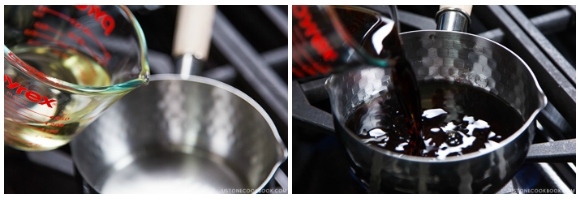
- Add 1 piece kombu (dried kelp) and ½–1 cup katsuobushi (dried bonito flakes). Use the maximum amount of katsuobushi for more intense bonito flavor.
![Zaru Soba New 3]()
- Bring it to a boil and simmer on low heat for 5 minutes. Turn off the heat. Let it steep and cool completely. Strain the mentsuyu and set aside. Tip: You can keep this concentrated soup base in an airtight container and store it in the refrigerator for up to a month.
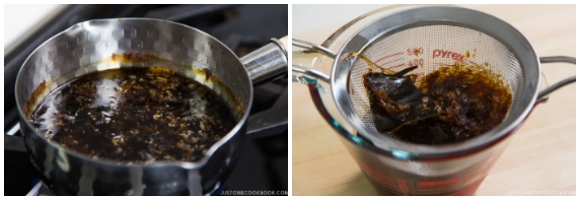
To Boil the Soba Noodles
- Boil a lot of water in a large pot. Unlike pasta, you do not add salt to the cooking water. Add 14 oz dried soba noodles (buckwheat noodles) to the boiling water, distributing them around the pot in a circular pattern to separate the noodles from each other. Cook the noodles according to the package instructions. Stir occasionally so they don’t stick to each other. The noodles are done when just tender; do not overcook. Reserve 1–1½ cups of the cooking water called sobayu and set aside to enjoy at the end of the meal.
![Zaru Soba New 5]()
- Drain the soba in a sieve and rinse them under cold running water with your hands to get rid of the excess starch. This is a very important step to keep the noodles from sticking to each other.

- Shake the sieve to drain the water completely. Then, transfer the noodles to a large bowl of iced water. Chill the noodles for 30 seconds, drain well, and set aside.
![Zaru Soba New 7]()
To Serve
- Place bamboo sieves or mats over individual plates (to catch the draining water from the noodles). Place one serving of soba noodles on each mat and garnish with shredded nori seaweed (kizami nori) on top.
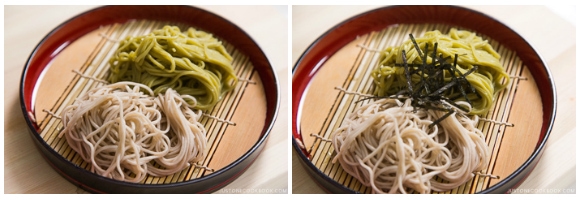
- Prepare the soba dipping sauce using a 1-to-3 ratio of homemade mentsuyu to water. Combine 6 Tbsp mentsuyu (concentrated noodle soup base) and 1⅛ cups iced water in a measuring cup and check the taste. If it‘s salty, add more water, and if it‘s too dilute, add more mentsuyu. Divide the dipping sauce into individual cups.
![Zaru Soba New 9]()
- Chop 2 green onions/scallions and put on individual small plates. Add a bit of wasabi to the plates. Serve with the soba noodles and individual cups of dipping sauce. When you’re done with the noodles, pour the reserved soba cooking water (sobayu) into the rest of the sauce in your dipping cup and enjoy it as a soup broth.
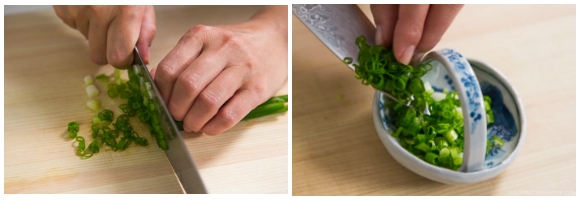
- For a more substantial meal, enjoy this Zaru Soba with a variety of vegetables like mushrooms, carrots, daikon radish, and lettuce/cabbage-based salads. It‘s also common to serve zaru soba with tempura, called tenzaru (天ざる). Try it with Vegetable Tempura and Shrimp Tempura.
To Store
- Store any leftover homemade mentsuyu in a clean, airtight container in the refrigerator for up to a month. I recommend cooking the soba noodles just before serving.
Nutrition
Calories: 348 kcal · Carbohydrates: 75 g · Protein: 15 g · Fat: 1 g · Saturated Fat: 1 g · Polyunsaturated Fat: 1 g · Monounsaturated Fat: 1 g · Sodium: 629 mg · Potassium: 267 mg · Fiber: 1 g · Sugar: 2 g · Vitamin A: 60 IU · Vitamin C: 1 mg · Calcium: 39 mg · Iron: 3 mg Course: Main CourseCuisine: JapaneseKeyword: cold noodle, soba noodles ©JustOneCookbook.com Content and photographs are copyright protected. Sharing of this recipe is both encouraged and appreciated. Copying and/or pasting full recipes to any website or social media is strictly prohibited. Please view my photo use policy here.
Editor’s Note: The post was originally published in August 2011. It’s been updated with new images and the video in July 2016. The post has been updated and republished in July 2020.


